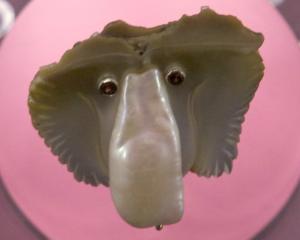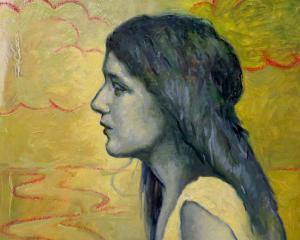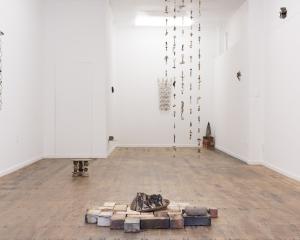There is a distinct sense of purpose about the characters depicted in the latest set of work by Kushana Bush on display at the Brett McDowell Gallery.
The artist has travelled extensively in the past year or so, allowing her to take in at first hand historical art from a variety of sources in Europe, Asia and the Americas, and she has successfully assimilated many of their stylings into her new paintings.
The influences of medieval European frescoes by the likes of Giotto and Latin American retablo and mural art now mix with the long-standing Oriental and South Asian feel of the artist's work, producing a new hybrid that is at once unique and familiar.
Bush has also honed her narrative skills in these latest works, and the current display largely shies away from the morbid focus of many of Bush's past images. The pieces have become more focused, the individual paintings now becoming distinct tableaux rather than a repetition of motifs. In works such as The pale ceremony, we are left to ponder the nature of the action taking place. The scenes are presented plainly against a stark grey background, the action therefore allowed to dominate the viewer's attention. The result is clear, strong, and highly effective.
The twin loves of the outdoor life and painting have intertwined for Kerry Fenton-Johns. The artist's sense of wonder for nature, be it in her garden or in the bush, and her eye for detail combine in these canvases, which speak of the flora of the places she loves.
The artist has used painting both as catharsis and as communication, pulling herself from depression through her art and also evoking and transmitting her sense of ''mindfulness'', the childlike joy at the glory of nature. By concentrating on the small details of the plants she depicts, the artist has transformed features of them into something known yet alien, seen and not seen. A strong sense of the depth of the foliage is also successfully conveyed.
The acrylic works are lush and strong; they instil a sense of the vibrancy of the environment that surrounds us. They are not photographic representations, yet are true to life. The detail of the flax flowers and nikau seem both realistic and impressionistic, as by homing in on the fine detail the recognisable elements become strange in the same way as with microscope slides; there is both precise rendering and idealised sweep in these sumptuous plant studies.
As with Kerry Fenton-Johns, so too is Nicki Gilmore attracted to the minutiae of nature. Gilmore, however, has taken a far more impressionistic approach, almost to the point of abstraction, with her studies of that most elusive subject, the play of light on the surface of water.
Whereas Fenton-Johns has taken her joy of detail as a jumping-off point, Gilmore revels in the scintillation of many-hued reflection. For this artist, realistic portrayal is as liquid as the surfaces that provide her subject matter. Gilmore's acrylic works, many of them shaped in ovals and circles that well suit their free-flowing patterns, seem to shimmer and float off the canvas. Colour is all, and colour is overwhelming.
In a nicely ambiguous line on her artist's statement, Gilmore says that she is currently working ''with the dynamic energy of clouds''. This could be a comment on her latest subject matter, but it could also well describe the shifting nature of the hypnotically rhythmic strands and hues within her paintings. There may be little of direct tangible substance in a painting of reflection, but - as masters of the genre such as Monet knew - that is irrelevant when you can paint with light.











![Rozana Lee, "Drawn to see(a)" [Installation view]. Photo: Beth Garey](https://www.odt.co.nz/sites/default/files/styles/odt_landscape_small_related_stories/public/story/2024/10/blue_oyster_r_lee.jpg?itok=IGhlKMSl)
